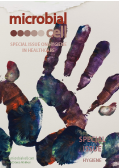Special Issues are flexible collections of articles, that have a common topic. The articles may be published in various monthly issues.
Reviews
Adaptive bacterial response to low level chlorhexidine exposure and its implications for hand hygiene
Günter Kampf
2019 | 10.15698/mic2019.07.683 | Full text | PDF | AbstractChlorhexidine digluconate (CHG) is commonly used in healthcare, e.g. in skin antiseptics, antimicrobial soaps, alcohol-based hand rubs and oral or wound antiseptics. Aim of the literature review was to evaluate the potential of bacteria to adapt to low level CHG exposure. A maximum 4fold MIC increase to CHG was found after low level exposure in most of the 71 evaluated bacterial species. A strong adaptive mostly stable MIC change was described in strains or isolates of the healthcare-associated species E. coli, S. marcescens and P. aeruginosa (up to 500fold, 128fold or 32fold, respectively). The highest MIC values after adaptation were 2,048 mg/l (S. marcescens) and 1,024 mg/l (P. aeruginosa). A new resistance to tetracycline, gentamicin, meropeneme or triclosan was found in some adapted isolates. In E. coli horizontal gene transfer was induced (sulfonamide resistance by conjugation), pointing out an additional risk of sublethal CHG. The use of CHG in patient care – but also all other settings such as consumer products and households – should therefore be critically assessed and restricted to indications with a proven health benefit or justifiable public health benefits. Additional CHG has no health benefit when used in alcohol-based hand rubs and is not recommended by the WHO. For routine hand washing of soiled hands the use of plain soap is sufficient, CHG in soaps has no health benefit. In surgical hand antisepsis alcohol-based hand rubs should be preferred to CHG soaps. Implementation of these principles will help to reduce avoidable selection pressure.
Laundry and textile hygiene in healthcare and beyond
Dirk P. Bockmühl, Jan Schages and Laura Rehberg
2019 | 10.15698/mic2019.07.682 | Full text | PDF | AbstractThe elimination of microbial contaminations from textile is an important aspect of laundering apart from the removal of stains and dirt from used and worn textiles. Although the framework for institutional laundering is well regulated to ensure hygienic cleanliness via the use of e.g. high temperatures and bleaching agents, there are several open points, especially in domestic laundering. In both cases, energy efficiency of appliances is a main driver for innovation and has resulted in a general decrease in washing temperatures which in turn can impact the antimicrobial efficacy of laundering. Thus, the different factors influencing the input and removal of microbial cells in the laundering process and possible adverse effects of microbial contaminants in the washing machine and on the textiles as well as suitable counteractions are discussed in this article, focusing on the clinical area but also considering the domestic environment, which will gain importance in the future, e.g. by the increase of elderly and ill persons being cared for at home.










